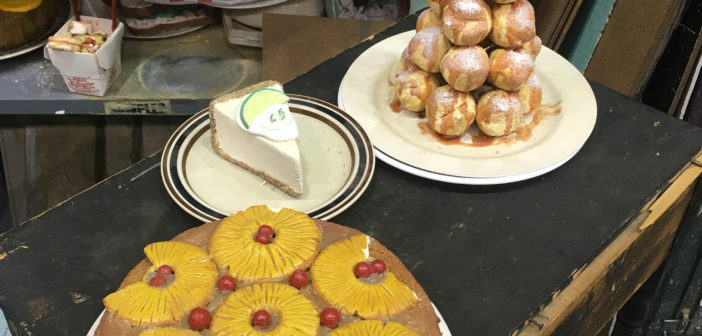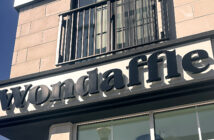Jack Daniels. Bacardi. Hennesy.
Empty liquor bottles line the wall.
What may sound like a typical off-campus house’s bottle collection is actually on campus, in the theatre department’s prop storage in Zoellner Arts Center. The department also stores larger props in a warehouse in Allentown.
Set designers for theatre department productions pull from the collection of props, some of which are created by students enrolled in theatre courses.
In addition to the prop storage area, students have access to a scene shop equipped for prop construction, metal working, theatrical rigging, and set construction and painting.
Stagecraft, scene painting and stage properties students contribute to the construction and decoration of production sets.
Adjunct professor Andrew Southard, who teaches Stagecraft I and II, has his advanced students build parts of the set. Southard said the stagecraft students learn and practice woodworking and metalworking techniques.
Students in the scene painting and stage properties classes paint and construct props and decor for the stage.
“We build and they make (the set) look pretty,” Southard said.
Though basic scene painting students primarily focus on painting and stage properties while decorations students primarily focus on prop construction, there is often overlap between the two courses.
“When there’s a more prop-intensive show, like ‘Betrayal’ was, then the props students focus on props,” said Bailey Sheehan, the paint and prop supervisor. “But the props students help with paint sometimes too, because there are often more painting techniques than there are props.”
The experimentation and practical experience students get from working in the scene shop are a critical component of the courses.
Sheehan said she gives students free time to independently experiment with materials.
“No show has the same set of props,” she said. “Each show you have to figure out how to build new props, and it’s a lot of trial and error.”
Melpomene Katakalos, an assistant professor of scenic design, said she thinks students enjoy classes like paints and props because they get to make something and, at the end of the production process, they get to see what they made be used on stage.
She said there are not many places on campus where students get to make things and that it is often difficult for a college education to provide actual practice, in addition to theory.
“The practical approach, I think, is really important,” Katakalos said. “You can theorize all you want and you can design all you want, but once you try to make (the product) it either works or it doesn’t and then you can problem solve and figure out how to do it correctly.”
While the department places emphasis on practice, Katakalos said the courses still incorporate humanities. She said the faculty want students to learn about theater, not just carpentry or painting skills, so they are familiar with the productions they are working on.
“(Students) understand the connection of the artistic intent of whatever is designed here and what they’re doing,” she said.
There are 13 students enrolled in painting and eight students enrolled in props this semester, but each section is restricted to a maximum of sixteen students.
Katakalos said there is a one-hour class each week that functions like a meeting to prepare students for their work in the lab. Students contribute four hours of lab work each week, and they can choose when to go to the scene shop.
Katakalos said students from a wide variety of majors and colleges take the courses.
IDEAS major Claire Ternes, ’20, designed the set for “Betrayal” and will design the set for “A Midsummer Night’s Dream,” runs in Fall 2018. Ternes’ major combines materials science engineering with an arts and sciences component, for which she will declare either theater/product design or design.
Ternes said she wants to bring some of her materials science knowledge into the materials she uses for the design in “A Midsummer Night’s Dream.”
“That’s one of my personal goals,” she said, “to bridge the gap between my two concentrations in this design.”
Katakalos said sets are designed by both faculty and students. She said whether she or a student designs a set depends on who is available to design that semester.
A student set designer works closely with Katakalos and Sheehan.
Sheehan said she and Ternes worked together to choose and mix paints and pull props for the set, and Ternes worked closely with Katakalos to create the actual design.
Sheehan said the design process also included significant research because “Betrayal” was set in the 1970s.
Ternes decided to take theater classes because she was involved in technical theater in high school and received a theatre scholarship from the university.
“The theatre department is open to anyone contributing, which is really good for exploring, because not everyone goes into college knowing what they want to do,” she said.
Ternes said this openness isn’t universally available. She said students may not be able to audition for shows at other schools unless they are theater majors.
In addition to the theater production work, students complete final projects unrelated to the productions.
Students in the props class, for example, create fake foods based on an assigned food, time period and location. In addition to researching the time period and location, students must provide an “ingredient list” of the materials, such as foam or clay, that they used to make the foods.
The primary focus of the courses, however, is the production work.
“I would say our production program is our biggest strength in this department,” Mellie said. “I would say it’s the reason why students are here — it’s the reason I’m here. Theater is not a theory, it’s a practice.”






Comment policy
Comments posted to The Brown and White website are reviewed by a moderator before being approved. Incendiary speech or harassing language, including comments targeted at individuals, may be deemed unacceptable and not published. Spam and other soliciting will also be declined.
The Brown and White also reserves the right to not publish entirely anonymous comments.